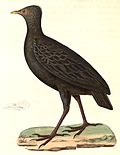Taxonomy
The genus Megapodius was introduced in 1823 by the French naturalist Joseph Gaimard. [1] He listed several species in his new genus but in 1840 the English naturalist Prideaux John Selby designated the type species as Megapodius freycinet, the dusky megapode. [2] [3] The genus name combines the Ancient Greek μεγας/megas, μεγαλη/megalē meaning "big" with πους/pous, ποδος/podos meaning "foot". [4]
The genus contains 12 species: [5]
| Image | Scientific name | Common name | Distribution |
|---|
 | Megapodius pritchardii | Tongan megapode | Tonga |
 | Megapodius laperouse | Micronesian megapode | Palau and the Northern Mariana Islands, Guam |
 | Megapodius nicobariensis | Nicobar megapode | Nicobar Islands (India) |
 | Megapodius cumingii | Philippine megapode | The Philippines, northeastern Borneo, and Sulawesi |
 | Megapodius bernsteinii | Sula megapode | Banggai and Sula Islands between Sulawesi and the Maluku Islands in Indonesia |
 | Megapodius tenimberensis | Tanimbar megapode | Tanimbar Islands of Indonesia |
 | Megapodius freycinet | Dusky megapode | Maluku and Raja Ampat Islands in Indonesia. |
 | Megapodius geelvinkianus | Biak scrubfowl | Biak, Mios Korwar, Numfor, Manim and Mios Numin in the West Papua region of Indonesia. |
 | Megapodius eremita | Melanesian megapode | Bismarck Archipelago (Papua New Guinea) and the Solomon Islands. |
 | Megapodius layardi | Vanuatu megapode | Vanuatu |
| Megapodius decollatus | New Guinea scrubfowl | Northern New Guinea and adjacent islands |
 | Megapodius reinwardt | Orange-footed scrubfowl | Lesser Sunda Islands as well as southern New Guinea and northern Australia. |
|
Two extinct species have been described from sub-fossil remains:
In all of the above, the name "scrubfowl" is sometimes exchanged with "megapode". Traditionally, most have been listed as subspecies of M. freycinet, but today all major authorities consider this incorrect. Nevertheless, there are unresolved issues within the genus, and for example the taxon forstenii has been considered a subspecies of M. freycinet, a subspecies of M. cumingii, or a monotypic species. An additional species, the Moluccan megapode, has sometimes been placed in Megapodius, but today most place it in the genus Eulipoa instead. The maleo is also associated with these genera, and together the three form a group.
This page is based on this
Wikipedia article Text is available under the
CC BY-SA 4.0 license; additional terms may apply.
Images, videos and audio are available under their respective licenses.















